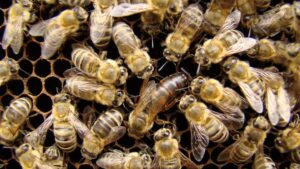The Agricultural Research Service (ARS) is organizing a national bee gene bank as part of the agency’s response to ongoing problems facing the country’s beekeepers. Average losses of managed honeybee colonies have increased to more than 30 percent per year due to pathogens, pests, parasites, and other pressures including deficient nutrition and sublethal impacts of pesticides. These stresses have threatened the continued business sustainability of commercial beekeepers.
The gene bank, which will be located in Fort Collins, Colorado, will help preserve the genetic diversity of honeybees, especially for traits such as resistance to pests or diseases and pollination efficiency. It will also provide ARS and other researchers access to resources from which to breed better bees, according to entomologist Robert Danka, with the ARS Honey Bee Breeding, Genetics, and Physiology Research Unit in Baton Rouge, Louisiana. Danka is helping shape the bee gene bank — the Russian honeybee and Varroa Sensitive Hygiene lines developed at the Baton Rouge lab will be among those conserved first.
To help make the gene bank a practical reality, ARS researchers are developing better long-term storage techniques for honey bees, including improving cryopreservation of bee sperm and embryos. Their work will include creating a way to reliably revive frozen embryos and grow them into reproductively viable adults after storage.
Another component needed to create the new genebank is a germplasm species committee, which will decide which species and subspecies to collect and preserve. ARS and Washington State University are working with beekeepers on the next steps for the committee.












